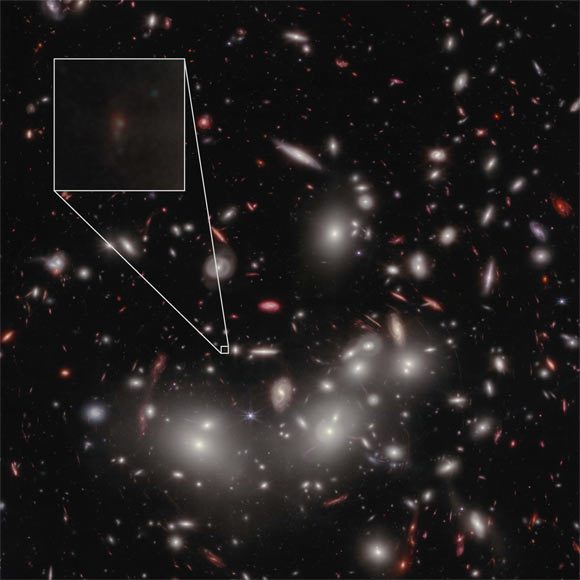Three ghostly images depicting the “face” of a 13.3 billion-year-old “ancestor” have come into focus through the lens of the James Webb Space Telescope, the advanced observatory currently orbiting Earth.
A research team led by Dr. Guido Roberts-Borsani from the University of California, Los Angeles (UCLA) utilized data from the Near Infrared Spectrograph (NIRSpec) of the James Webb Space Telescope—developed and primarily operated by NASA—to identify the ancient dwarf galaxy JD1.

One of the “faces” of the ancient object JD1, magnified by Abell 2733 – (Image: NASA/ESA/CSA).
The recently published research in the scientific journal Nature shows that the images captured by James Webb of this galaxy are from a time when the universe was only 480 million years old, specifically 480 million years after the Big Bang.
The intrigue increases as we can see not just one but up to three JD1s from Earth’s perspective, due to the “gravitational lensing” effect, where nearer cosmic objects bend space-time, resulting in the duplication of the object.
One of the gravitational lenses involved in this event is the massive galaxy Abell 2733, which spans 350 million light-years across and is located about 4 billion light-years away from us.
This effect also makes JD1 appear larger and clearer, like looking through a magnifying glass, allowing James Webb to detect it despite its relatively faint and blurry nature.
JD1 is a small galaxy compared to the entire Milky Way that contains Earth, yet it is still a formidable giant in the context of the tiny celestial body we inhabit. It’s even more remarkable considering it formed in a chemically impoverished early universe.
This image has also traveled a distance of 13.3 billion light-years to reach Earth—meaning it took over 13.3 billion years in terms of time—a genuine time-travel experience that enables humanity to gaze directly into the early universe.
“The combination of James Webb and the magnifying power of gravitational lensing is revolutionary. We are rewriting the book on how galaxies formed and evolved right after the Big Bang,” said Professor Tommaso Treu, a co-author from UCLA.
This new discovery promises to clarify many details about how the universe has evolved and the origins of our planet, which is a product of a chemically enriched universe shaped by numerous generations of stars and planets in ancient galaxies that formed and then dispersed.


















































